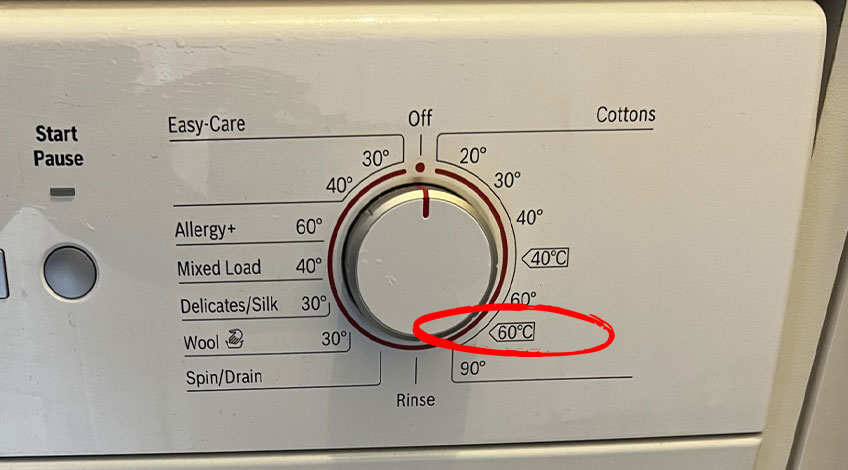
What Temperature Is Best To Wash Cotton At? (& how to dry it)
People have been wearing clothes made from cotton for many years, and for good reason, it’s soft and as it breathes so well, it can be worn all year round. Plus if you wash cotton the right way it will last a long time. As with many fabrics, cotton should be washed at low temperatures if you want it to last and prevent colour fade and shrinkage.
If you want to know the right temperature to wash your cotton items at and the best way to dry them, keep reading.
What Temperature Should You Wash Cotton At?
Cotton is used to make many items, from socks, underwear, shirts, t-shirts, shorts, towels and bedding. To ensure these items remain germ and bacteria free as well as clean and stain free, you’ll need to employ different wash cycles.
You’ll need to be mindful of the effect heat can have on certain items as it’s all too easy to damage cotton items by using the wrong temperature in the wash.
It’s always best practice to wash cotton items at the lowest temperature you can. This will preserve the colour, reduce the risk of shrinking and make the items last longer.
Washing At 30 Degrees C
A 30 degree wash is considered a cool wash and is perfectly fine for washing cotton items that are not too dirty or are unlikely to have a high level of bacteria.
30 degrees is not hot enough to remove heavily ingrained stains or many germs and bacteria. We would not recommend washing cotton socks, underwear, bedding or towels at 30 degrees as these will need a hotter wash to remove bacteria.
However, you could wash the above items at 30 degrees as long as they are not heavily soiled. You could add a laundry sanitiser to the wash coupled with a good quality detergent to ensure all of the germs and bacteria are dealt with.
A 30 degree wash would be good from the point of view that cotton is less likely to shrink at such a low temperature.
Washing At 40 Degrees C
A 40 degree wash is hotter which means it is more likely to remove stubborn stains and bacteria that would be left behind at 30 degrees. But not so hot that the fabric is likely to shrink.
However, there are still stains and bacteria that can withstand a 40 degree wash. Having said that, 40 degrees should be safe to wash cotton items that you know are colour fast.

Washing At 60 Degrees C
A 60 degree wash cycle is a hot cycle which means the water molecules are moving rapidly. This is a great temperature to remove ingrained stains and much of the bacteria left behind at 30 and 40 degrees.
The 60 degree wash cycle is perfect for bedding and towels which are in constant contact with our skin which means they are likely to contain lots of germs and bacteria.
Stains are removed easily because of the rapid movement of the water molecules which causes the fabric to release the trapped dirt. That same rapid movement assists in the removal of germs and bacteria.
However, it can be too hot for some cotton items which is why you should always check the wash care label for washing and drying instructions.
Washing At 90 Degrees C
A 90 degree wash cycle is a very hot wash cycle and should not be used for many fabrics at all.
In fact, there are only certain cotton items that are OK to be washed at 90 degrees which include;
- White towels
- Socks
- Bed sheets
- Some sportswear.
What Are The Pros & Cons Of Washing Cotton Items At Low Temperatures?
Let’s summarise the main advantages and disadvantages of washing cotton items in a cool wash.
The Benefits
The main benefits include;
- Less likely to shrink clothes
- Less likely to fade colours
- Less likely to damage clothes
- Energy saving
- Environmentally friendly
The Downfalls
The main disadvantages include;
- Less likely to remove stubborn stains
- Less likely to remove bacteria
What Are The Pros & Cons Of Washing Cotton Items At High Temperatures?
Now, let’s summarise the advantages and disadvantages of washing cotton items at high temperatures.
The Benefits
The main benefits include;
- The removal of stubborn stains
- The elimination of harmful germs & bacteria
The Downfalls
- Likely to shrink some delicate items
- Can cause colour run and fade
- Costs more
- Uses more electricity
- Less environmentally friendly
How To Dry Cotton Items
The best and safest way to dry cotton items is air drying. You can either hang the items on a line or lay them flat. Many cotton items can be tumble dried but you should check the wash care label first.
The high heat and rough and tumble action from a tumble dryer is likely to shrink 100% cotton items. In fact, tumble drying cotton is more likely to cause cotton items to shrink than washing them.
If the care label indicates that it’s OK to tumble dry your cotton item, you should use a low heat setting or medium heat setting, never the high heat setting. Unless you actually are trying to shrink the item.
To help prevent 100% cotton from shrinking in the dryer, you should remove all items before they are fully dry.

Why Does Cotton Shrink?
Cotton fabric is made up of individual strands of cotton fibre that are pulled and stretched to create the material used for making clothes etc.
When cotton is exposed to high temperatures, those fibres relax and return to their original size. In some cases this can be reversed, but not always. This is why we never recommend washing cotton at high temperatures with a few exceptions.
How To Reverse The Shrinking Process
If some of your cotton garments have shrunk in the washer or dryer, it is sometimes possible to reverse the shrinking process. You’re more likely to get positive results if the items have shrunk in the washer than in the dryer.
This is because once the fibres are completely dry they have fixed into shape. It’s still worth giving this a try but you’ll have more success with just washed shrunken clothes than dried shrunken clothes.
All you need is baby shampoo, a bowl and lukewarm water, and then follow these simple steps (it’ll only take you around 40 minutes);
- Make A Soak
Mix baby shampoo or hair conditioner into a bowl of lukewarm water. - Soak The Shrunk Item
Place the shrunken item in the bowl and agitate to ensure the solution gets into all of the fibres. Allow to soak for at least 30 minutes. - Reform The Item
After 30 minutes, remove the item from the soak and gently stretch the fabric back into its original shape. Take care to not pull too far in one direction, pull a little at each point of the fabric. - Air Dry The Item
Once you’re sure the item has been restored to its original shape and size, air dry it.
Can Preshrunk Cotton Shrink?
Due to the nature of the cotton fibres, all cotton is prone to shrinking even preshrunk cotton. To be fair, preshrunk cotton is less likely to shrink as much as cotton that hasn’t been preshrunk, but it still has the potential to shrink if washed or dried incorrectly.
SEE ALSO: Is A 15 Minute Wash Cycle Enough To Clean Clothes?
Frequently Asked Questions
You can wash 100% cotton at 40 degrees C. This temperature is ideal for washing 100% cotton and cotton blends without causing the fabric to shrink or any colours to run.
With the advent of newer, better detergents that are able to clean clothes at lower temperatures, it is OK to wash cotton at 30 degrees. However, you might not get as good results washing at 30 degrees as you would at 40 degrees. There are many stains and bacteria that will survive a 30 degree wash.
It is OK to wash some cotton items at 60 degrees. You should always check the wash care label first as some cotton items are prone to shrink at 60 degrees.




